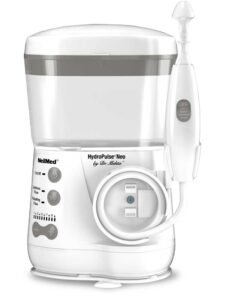Sinus Headaches
Do you have Sinus Headaches?
Many patients are bothered by pain above the nose and between the eyes, where the sinuses are located. If there is a severe nasal inflammation, this may respond to papaya enzyme tablets (don’t get the ones from the health food store, they’re usually useless; details here), one four times a day, dissolved in the mouth between the cheek and gums. This is especially useful if the pain follows flying or scuba diving. Non-steroidal medications such as Aleve may be helpful. This is especially useful if the pain follows flying or scuba diving. If infected, this requires an antibiotic and a decongestant such as Sudafed.Ê Avoid chilling and drink lots of hot tea till the urine turns light. Green tea with or without caffeine is best. If there is drainage, Pulsatile Nasal Irrigation is an excellent way to remove pus and stimulate natural nasal function.
Real sinus pain is actually rare, even when the patient is blowing yellow mucous out the nose. In many cases the “sinus headache” is really “referred” pain from the neck. Feel the back of your neck. Does the pain travel to the front of your forehead? This is because of the hookup of the nerves; painful stimuli radiates to the front area above the eyes. For neck treatment see Cervical Pain.
Pain
Pain in the sinus comes from pressure on the membranes. Often the most severe pain comes when a vacuum is formed. For example, flying at high altitude your nose may clog because of the dryness in the cabin and your failure to drink adequate fluids, such as hot tea. The nose closes and almost immediately the body starts to absorb the oxygen in the sinus which is now plugged. On landing, the sinus is now at a low pressure whereas the atmosphere outside is at a higher pressure 15 psi (100 kN / square m)- the pain is like having a 5 pound weight (~ 2 kg mass) on your eyeball. A similar thing can happen in scuba diving.
Treatment consists of opening the sinus passages so the air pressure can equalize. Spray the nose with a nasal decongestant. The doctor may give you cortisone by injection or pill to get the passages open. Take papaya enzyme tablets every four hours, dissolved in the mouth between the cheek and gums. Taking a decongestant like Sudafed or Zephrex LA is good. In my office we spray the nose well and put pledgets (small wads) of cotton with nose drops at the sinus openings. Sometimes the patient breathes helium which easily goes into narrow openings. If you have a clogged nose and vacuum in the sinuses this is a very painful conditins and we do give pain medicine as needed. The nasal irrigator is recommended if there is phlegm or drainage that should be removed at home.
Pain from bacterial sinus infections is surprisingly rare, even when the x-rays show significant disease. Drainage of the pus is done in the office, especially local shrinking and suction, and daily at home using the pulsatile nasal irrigation. Antibiotics are also used, plus decongestant and papaya as above. Apply hot compresses over the sinus area, and drink hot tea, about 8 glasses a day, to help restore movement to the microscopic cilia of the nose and sinuses. Sometimes nasal pain is due to extreme swelling of the membranes against a deviated nasal septum or nerve area.
If someone has pain in cold air, while skiing for example, we consider that they may have a wide nose so that the bones don’t come together, where the roof of the nose is open, allowing cold air to strike the membranes directly.
The trigeminal nerve is in 3 parts to transmit pain sensations from the face. The nerve can be irritated by a viral infection and cause a neuralgia. We diagnose this by the distribution of the nerve. Trigeminal neuralgia is a nerve irritation that is quite painful and requires good care, but can be helped. This type of pain is not helped by relaxation or exercises .

